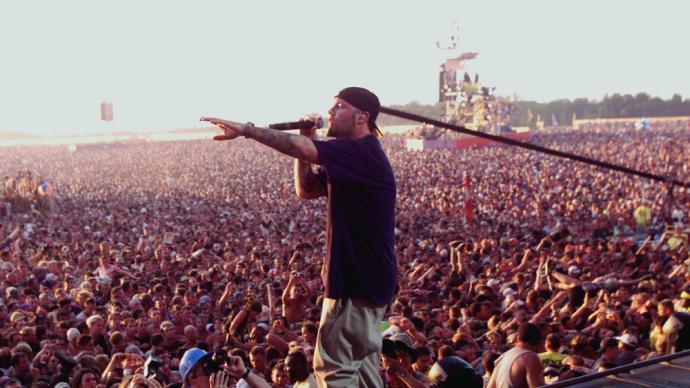
The 1999 Woodstock Festival was one of the most famous events of the late twentieth century. Its slogan is moving: mending broken youth culture in the wake of the Columbia school shooting. The motives are very real: fix the barriers, prevent ticket evasion, and try to make as much money as possible. The results were appalling: riots, arson, rape turned the festival into hell on earth. It goes down in history as well as the inaugural Woodstock in 1969. After three nights and four days, 44 people were arrested, 8 rape cases were reported, and more than 10,000 people needed to be admitted to the hospital for treatment, which wiped out the lingering goodwill of hippie culture in mainstream American society.
Last summer, HBO made a documentary about it: "Woodstock 99: Peace, Love, and Rage", asking why it happened. One by one, speaking in front of the camera, trying to answer these questions: Is it because the artist is inciting negative emotions and encouraging everyone to vent their dissatisfaction? Is it because the organizer is greedy for money and allows food and beverage suppliers to "sell as much as they can" in the hot weather, but hardly provides shade, causing crowd riots? Is it because the youth of the 1990s mistakenly used the "free love" of the 1960s as an excuse for assaulting women? Or is it just because more than 250,000 people came and so many hormones burned in the wild (actually an air force base) for three days and nights, curbing human nature and unleashing bestiality?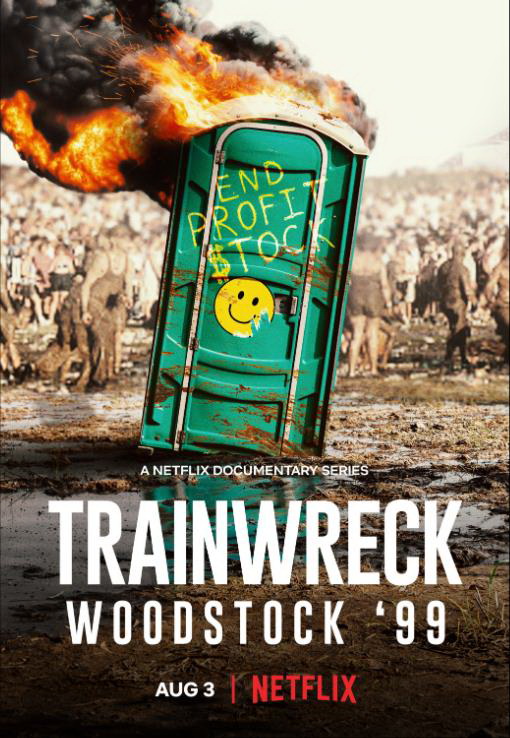
Why do human beings suddenly have a wild beast at a certain moment and make incredible actions? Don't rush to answer this question first, let's take a look at this famous music festival.
Woodstock in 1969 was an accidental gap in history, a beautiful accident that rarely happens in everyday life. Promoter Michael Long and three other partners (John Roberts, Joel Roseman, Artie Kornfeld) paid $135,000 for all the participating bands. Few of these performers are favored by the mainstream media, and most of them are young musicians outside the commercial music market.
Music started at 5:07 p.m. on April 29, 1969, and there was no break in Woodstock music until the crowd dissipated on Monday morning.
The birth of Woodstock was the result of too many factors—the combined effects of events like Watergate, Stonewall, the Vietnam War, the disgust of middle-class values among the postwar generation of young Americans, and the skepticism of the capitalist system. Young people in affluent environments began to pay attention to freedom and the mind, and had an unprecedented rejection of daily routines.
These accumulated emotions do not need to lift their arms. Countless young people come to Asgar Farms, 90 minutes from New York Station, in the congestion, with the same young Jimi Hendrix, Joan Baez, Jenny Joplin, Neil Young, John Sebastian, The Who, Jefferson Airplane, Country Old Joe and the Fish, The Grateful Dead, Credence Clearwater Revival created this Rare moment.
Suddenly, forty or fifty thousand people poured into the meadows of the farm. The number was inaccurate because young people who arrived early before the ticket booths and railings were erected thwarted plans to sell tickets. The organizer temporarily announced that the music festival would be free, and the cost would be recovered by selling the copyright of the live documentary.
In 1994, Michael Lang ran Woodstock again. But because of the gap in the fence, the spectators poured in again for free, and no money was made. To do it again in 1999, no matter how lofty the rhetoric, Michael Lang's original intention is very simple, to make up for the loss in 1994. This time the fence is foolproof, but unfortunately this time its signboard is disgraced. By the time Woodstock's 40th anniversary in 2009, there were no more sponsors willing to pay.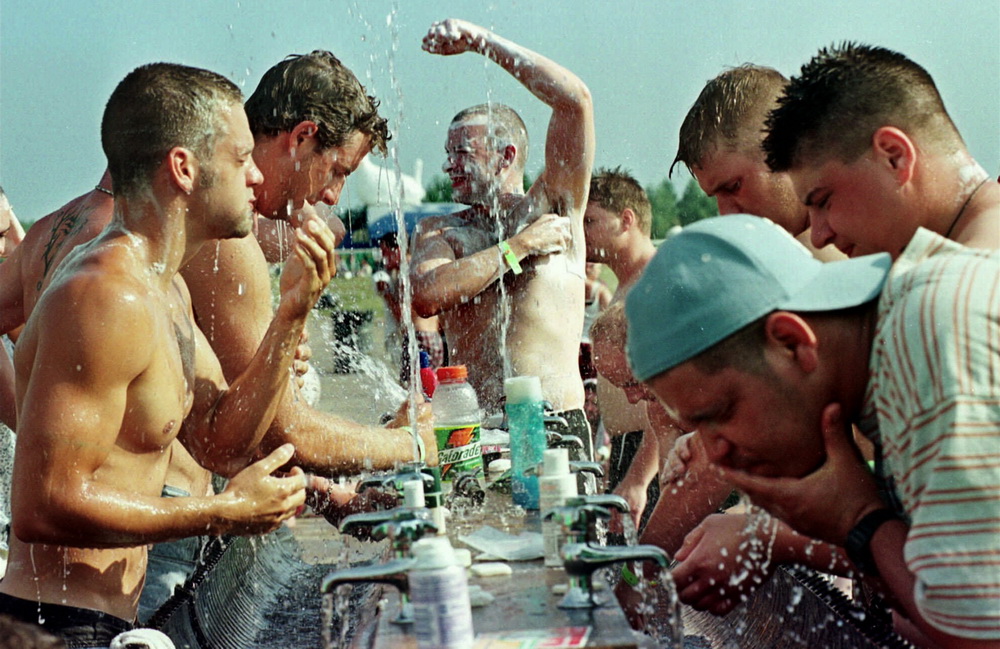
The chaos recorded in the video material presents a crisp and continuous texture, like a flaming domino. Peace candles were used to light anything that could be lit; lighthouses were dragged to the ground like scalped trophies; stalls were looted; ATMs opened their mouths with empty stomachs; There was a heavy, dirty snowfall. "This is Lord of the Flies," said one participant.
On Monday, who knows who, wrote a word on the remaining wall: "Greed". Before this wall was burned down, it also had a name called "Peace Wall".
Interspersed interviews showcase the art of kicking the ball: one organizer blames another, the audience blames the artist, the artist calls the audience "too scary", the audience feels like a victim, and every penny they bring is spent on expensive water , food and alcohol, people are exposed to a layer of skin, and the vague ideals are shattered. There seems to be no one who thinks that he, as a part of the scene of the year, bears any responsibility for the corruption of things.
The Limp Bizkit debuted on the second night. More than 200,000 people slept randomly all night, did not drink enough water, took too much alcohol and drugs, and in this case ushered in the most popular and frenzied band (one of the year). Fred Durst came to the stage and spoke to the audience about their dissatisfaction with reality. Like a conductor on a pyramid, he looked down on the surging crowd of 25,000 people. It can be seen in the camera that Ren Lang slaps the stage under his command. The cardboard turned into a boat on the sea, and young men scrambled to stand on the boat and surf on the crowd. Someone stormed the stage and jumped over the security to climb the three-dimensional structure of the stage. From a distance, confetti-like objects are thrown into the air one after another. People played pogo, and at the beginning, there were also girls participating. As the force of the impact became stronger each time, their facial expressions changed: from relaxed, to accumulating, and then angry, the pogo that was supposed to be friendly became mutual. beat.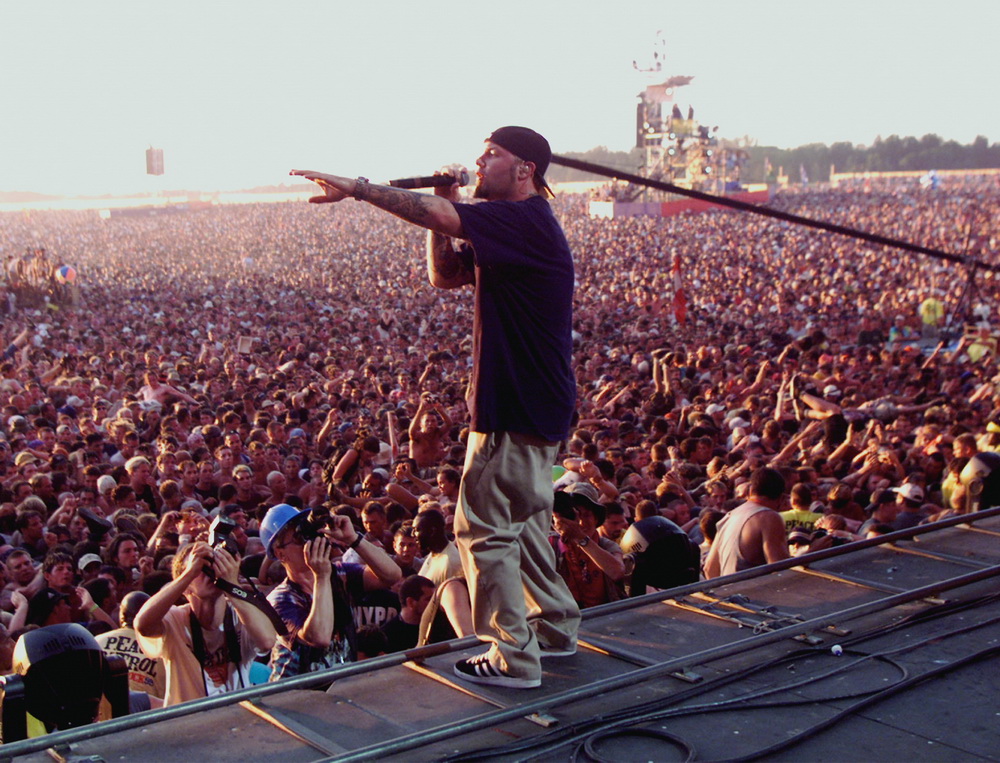
Another reporter with a microphone asked Durst on the way to the backstage if he felt the stage shaking? Durst smiled and said, "Dude, it's not my fault." The camera cuts to one of the promoters, John Scher, sitting in a spacious office, and swears: "Durst is a big jerk, It's all his fault."
After the festival, heat, lack of water and "soft biscuits" were designated as the three deadly sins that led to the chaos.
"99 Woodstock" is used as a negative teaching material for music festivals, reminding other music festival organizers which minefields should be avoided. But obviously, not all the organizers are willing to learn a lesson and earn a little less money, so that young people who have worked hard to participate in music festivals (it is always tiring to participate in music festivals) have at least the dignity of being a human being - to be able to eat and drink enough Water, toilet not too dirty, no need to hurt.
It is also a human experiment out of control. The scale is huge and the cost is high. The results of the experiment once again confirm the fragility of civilization - establishment, it takes a long time and requires the unremitting efforts of several generations; collapse, if the conditions are right, it only takes three days .
It wasn't any band's fault, and it wasn't just because of the heat and lack of water. Rather, from the very beginning, the audience was not treated as a "person". As the main body of "youth culture" in the propaganda, they are only used as money bags with the label of "youth". Anyone with common sense would have expected 250,000 people to use dirty toilets, scramble for water and food, and have higher and higher concentrations of alcohol and drugs under a poisonous sun with no view or shade. what happens in the case.
The (imagined) happiness is fleeting, and several interviewees mentioned "animals" and "bestiality." When people are not treated as people, there is only one possibility of returning to the ancestors and turning back to animals. But don't insult the animals, our primate ancestors have already formed their own rules: monkeys have monkey rules, gorillas have gorillas, chimpanzees have chimpanzees. And human beings, once freed from the constraints of existing rules and unable to form new rules in a short period of time, will become like 99 Woodstock. The instincts of destruction, looting, wounding, and self-defense are in the body, and when faced with disappointment and deprivation, and without restraint, it will surge out.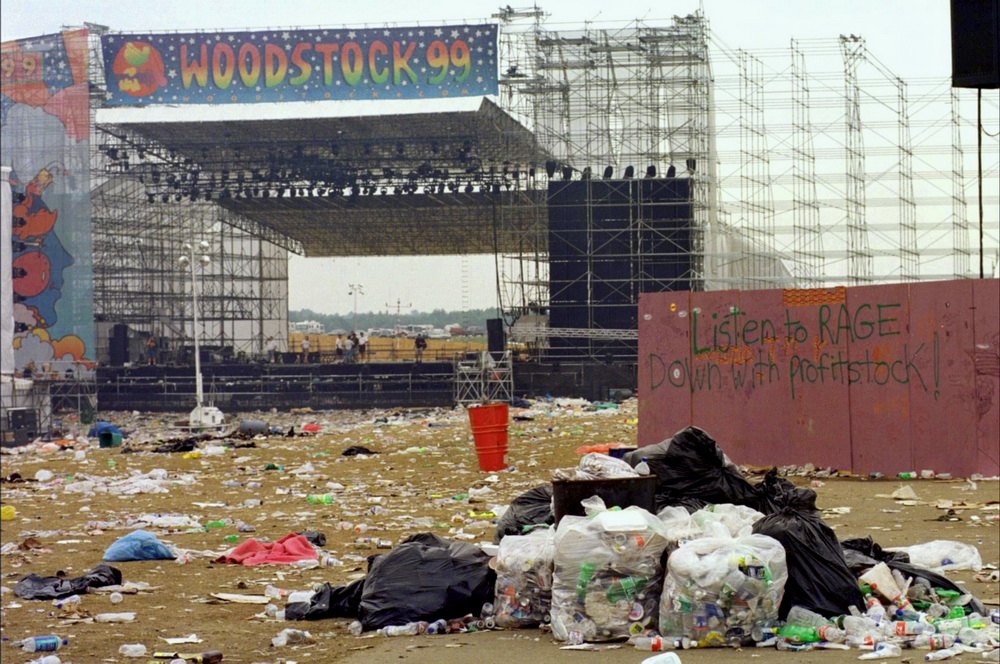
Lack of consensus - lack of resources - destruction of order, in the grand scheme of things, the collapse of civilization is nothing more than that.
Last summer, HBO made a documentary about it: "Woodstock 99: Peace, Love, and Rage", asking why it happened. One by one, speaking in front of the camera, trying to answer these questions: Is it because the artist is inciting negative emotions and encouraging everyone to vent their dissatisfaction? Is it because the organizer is greedy for money and allows food and beverage suppliers to "sell as much as they can" in the hot weather, but hardly provides shade, causing crowd riots? Is it because the youth of the 1990s mistakenly used the "free love" of the 1960s as an excuse for assaulting women? Or is it just because more than 250,000 people came and so many hormones burned in the wild (actually an air force base) for three days and nights, curbing human nature and unleashing bestiality?

Totally Out of Control: 1999 Woodstock Music Festival
A year later, Netflix launched a new documentary "Trainwreck: Woodstock 99" on the same theme. Director Jamie Crawford made it like a war thriller, where fear surrounds you and takes you back to those three fallen wilderness nights at the end of the century. The audience, artists and crew interviewed in the film can only tell you their feelings and perspectives. What happened and why at Woodstock in 1999, this film is only responsible for providing detailed and real video information. You have to experience it for yourself, just like someone who has experienced it.Why do human beings suddenly have a wild beast at a certain moment and make incredible actions? Don't rush to answer this question first, let's take a look at this famous music festival.
Woodstock in 1969 was an accidental gap in history, a beautiful accident that rarely happens in everyday life. Promoter Michael Long and three other partners (John Roberts, Joel Roseman, Artie Kornfeld) paid $135,000 for all the participating bands. Few of these performers are favored by the mainstream media, and most of them are young musicians outside the commercial music market.
Music started at 5:07 p.m. on April 29, 1969, and there was no break in Woodstock music until the crowd dissipated on Monday morning.
The birth of Woodstock was the result of too many factors—the combined effects of events like Watergate, Stonewall, the Vietnam War, the disgust of middle-class values among the postwar generation of young Americans, and the skepticism of the capitalist system. Young people in affluent environments began to pay attention to freedom and the mind, and had an unprecedented rejection of daily routines.
These accumulated emotions do not need to lift their arms. Countless young people come to Asgar Farms, 90 minutes from New York Station, in the congestion, with the same young Jimi Hendrix, Joan Baez, Jenny Joplin, Neil Young, John Sebastian, The Who, Jefferson Airplane, Country Old Joe and the Fish, The Grateful Dead, Credence Clearwater Revival created this Rare moment.
Suddenly, forty or fifty thousand people poured into the meadows of the farm. The number was inaccurate because young people who arrived early before the ticket booths and railings were erected thwarted plans to sell tickets. The organizer temporarily announced that the music festival would be free, and the cost would be recovered by selling the copyright of the live documentary.
In 1994, Michael Lang ran Woodstock again. But because of the gap in the fence, the spectators poured in again for free, and no money was made. To do it again in 1999, no matter how lofty the rhetoric, Michael Lang's original intention is very simple, to make up for the loss in 1994. This time the fence is foolproof, but unfortunately this time its signboard is disgraced. By the time Woodstock's 40th anniversary in 2009, there were no more sponsors willing to pay.

"Total Out of Control" stills
What was the scene like in 1999? "Totally Out of Control" shows the boys holding big "Show your boobs" cards and waving them at the female audience in the crowd. When surfing in the crowd, the girls become prey. The artist looked like a cult leader on stage, waving his arms and calling on everyone to release their anger.The chaos recorded in the video material presents a crisp and continuous texture, like a flaming domino. Peace candles were used to light anything that could be lit; lighthouses were dragged to the ground like scalped trophies; stalls were looted; ATMs opened their mouths with empty stomachs; There was a heavy, dirty snowfall. "This is Lord of the Flies," said one participant.
On Monday, who knows who, wrote a word on the remaining wall: "Greed". Before this wall was burned down, it also had a name called "Peace Wall".
Interspersed interviews showcase the art of kicking the ball: one organizer blames another, the audience blames the artist, the artist calls the audience "too scary", the audience feels like a victim, and every penny they bring is spent on expensive water , food and alcohol, people are exposed to a layer of skin, and the vague ideals are shattered. There seems to be no one who thinks that he, as a part of the scene of the year, bears any responsibility for the corruption of things.
The Limp Bizkit debuted on the second night. More than 200,000 people slept randomly all night, did not drink enough water, took too much alcohol and drugs, and in this case ushered in the most popular and frenzied band (one of the year). Fred Durst came to the stage and spoke to the audience about their dissatisfaction with reality. Like a conductor on a pyramid, he looked down on the surging crowd of 25,000 people. It can be seen in the camera that Ren Lang slaps the stage under his command. The cardboard turned into a boat on the sea, and young men scrambled to stand on the boat and surf on the crowd. Someone stormed the stage and jumped over the security to climb the three-dimensional structure of the stage. From a distance, confetti-like objects are thrown into the air one after another. People played pogo, and at the beginning, there were also girls participating. As the force of the impact became stronger each time, their facial expressions changed: from relaxed, to accumulating, and then angry, the pogo that was supposed to be friendly became mutual. beat.

Still Out of Control, Fred Durst
At this time, the fledgling music reporter found that a girl beside her was smashed and bleeding on the head, and the security dragged her away through the crowd. The reporter followed the girl to the medical center and saw more wounded and more blood. The medical staff expressed the fear of "wanting to escape immediately", because he found that the medical supplies were all used up in a blink of an eye, and the injured were still being sent in a steady stream.Another reporter with a microphone asked Durst on the way to the backstage if he felt the stage shaking? Durst smiled and said, "Dude, it's not my fault." The camera cuts to one of the promoters, John Scher, sitting in a spacious office, and swears: "Durst is a big jerk, It's all his fault."
After the festival, heat, lack of water and "soft biscuits" were designated as the three deadly sins that led to the chaos.
"99 Woodstock" is used as a negative teaching material for music festivals, reminding other music festival organizers which minefields should be avoided. But obviously, not all the organizers are willing to learn a lesson and earn a little less money, so that young people who have worked hard to participate in music festivals (it is always tiring to participate in music festivals) have at least the dignity of being a human being - to be able to eat and drink enough Water, toilet not too dirty, no need to hurt.
It is also a human experiment out of control. The scale is huge and the cost is high. The results of the experiment once again confirm the fragility of civilization - establishment, it takes a long time and requires the unremitting efforts of several generations; collapse, if the conditions are right, it only takes three days .
It wasn't any band's fault, and it wasn't just because of the heat and lack of water. Rather, from the very beginning, the audience was not treated as a "person". As the main body of "youth culture" in the propaganda, they are only used as money bags with the label of "youth". Anyone with common sense would have expected 250,000 people to use dirty toilets, scramble for water and food, and have higher and higher concentrations of alcohol and drugs under a poisonous sun with no view or shade. what happens in the case.
The (imagined) happiness is fleeting, and several interviewees mentioned "animals" and "bestiality." When people are not treated as people, there is only one possibility of returning to the ancestors and turning back to animals. But don't insult the animals, our primate ancestors have already formed their own rules: monkeys have monkey rules, gorillas have gorillas, chimpanzees have chimpanzees. And human beings, once freed from the constraints of existing rules and unable to form new rules in a short period of time, will become like 99 Woodstock. The instincts of destruction, looting, wounding, and self-defense are in the body, and when faced with disappointment and deprivation, and without restraint, it will surge out.

"Total Out of Control" stills
There are other explanations, such as the profit-heavy businessman who is focused on harvesting leeks, and the leeks believed in the cakes drawn by the merchants, thinking that they would be thrown into the ocean of idealism by spending money to buy tickets. Unexpectedly, the ideals of love and peace have long been replaced by carnival. Is there any difference between the Woodstock participants of the 1960s and the 1999s? About the same age, the same level of hormones, the difference is that the young people of that year placed great emphasis on "love" and "peace". The two forces competed against each other and calmed their minds. The youth of 1999, attracted by the mud and wildness of "Woodstock", were ready to "release". They came to the appointment with the desire to temporarily abandon "civilization" and "peace", and they laid the foreshadowing of runaway from the beginning. At the turn of the millennium, the social environment and youth culture that gave birth to "love and peace" have long since ceased to exist. You must know that idealism supported by social consensus is still fragile, not to mention the unsupported picture of a cat and a tiger.Lack of consensus - lack of resources - destruction of order, in the grand scheme of things, the collapse of civilization is nothing more than that.
Related Posts